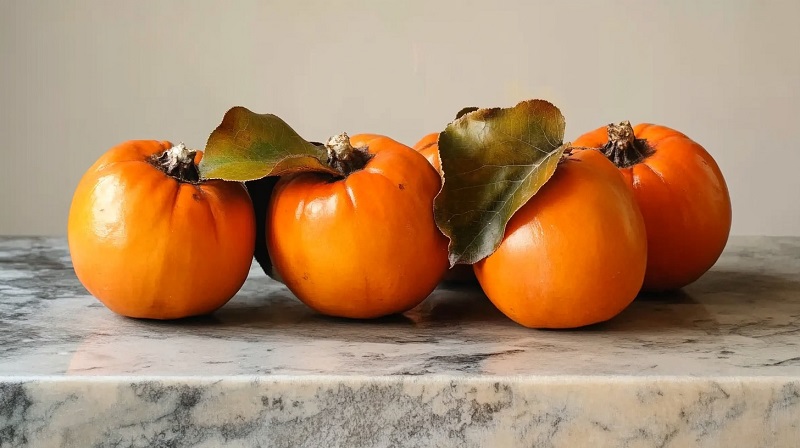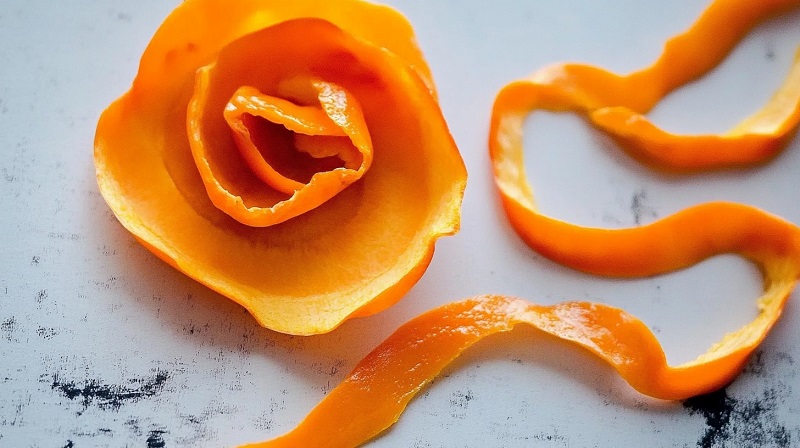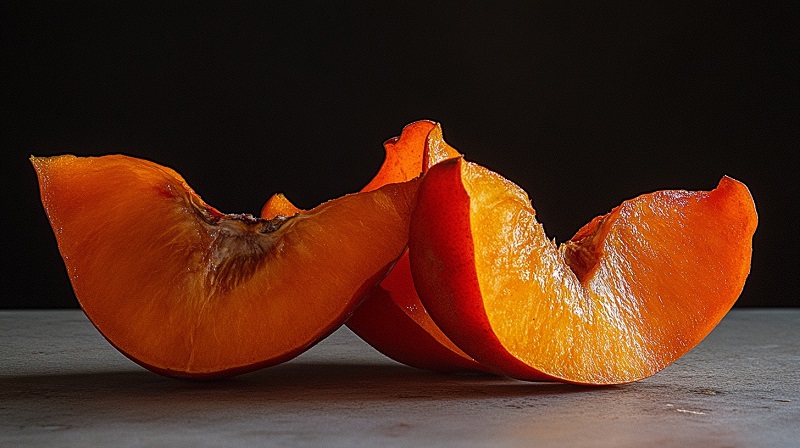Persimmon often shows up in markets with bright orange skin and smooth texture. The fruit tastes rich and sweet, but many pause before biting through the peel. Some eat it without hesitation. Others always remove it. The skin raises questions about texture, flavor, and health value.
Different types of persimmons behave differently. Fuyu stays firm and crisp. Hachiya turns soft and pulpy. Some skins feel thin and pleasant. Others turn rubbery or bitter. The peel also holds fiber and antioxidants, but it may carry pesticides if not washed properly.
Taste, digestion, and personal comfort all shape the answer. A closer look at each variety, along with expert advice, helps clear the confusion.
Fuyu vs Hachiya: Why the Type of Persimmon Matters
Not all persimmons are the same. The peel reacts differently based on the type of fruit. Texture, taste, and even safety depend on variety. Fuyu and Hachiya dominate store shelves, but each one tells a different story when it comes to eating the skin.

Fuyu Persimmons: Firm, Mild, and Peel-Friendly
Fuyu persimmons are non-astringent. They can be eaten while still firm. Their skin feels smooth and thin, making it pleasant to bite through. Most people find the peel on Fuyu to be completely edible.
- Firm texture supports the skin
- Mild flavor matches well with the peel
- Peel stays intact without becoming bitter
Hachiya Persimmons: Soft, Astringent, and Messy with Peel
Hachiya persimmons must ripen fully before eating. Once ripe, the inside turns into a soft, jelly-like texture. The skin can feel rubbery or slightly bitter.
- Astringent when unripe
- Very soft when ripe, making the peel harder to enjoy
- Many scoop the inside and leave the skin
Comparison
| Feature | Fuyu Persimmon | Hachiya Persimmon |
|---|---|---|
| Ripeness | Eaten firm | Must ripen fully |
| Skin Texture | Thin and smooth | Rubbery or papery |
| Taste with Peel | Mild and pleasant | May taste bitter |
| Ease of Eating Peel | Easy | Often skipped |
What the Peel Contains: Nutrients, Fiber, and Antioxidants
The peel does more than protect the fruit. It adds value to your health. Most of the fiber sits in or near the skin. Antioxidants and vitamins also concentrate there. Skipping the peel may mean missing out on important benefits.

Fiber Content: Helps Digestion and Fullness
Persimmon peel carries dietary fiber. That supports digestion and may help regulate blood sugar. It also promotes fullness, which helps with portion control.
- Promotes gut health
- Slows down sugar absorption
- Supports longer satiety
Antioxidants: Protection at the Surface
The peel holds flavonoids, tannins, and carotenoids. These compounds may help reduce inflammation and protect cells from damage.
- Carotenoids support eye health
- Flavonoids help reduce oxidative stress
- Tannins offer some protection but may affect taste
Vitamins in the Peel
The skin provides a small amount of vitamins A, C, and E. These support immunity, skin repair, and overall health.
| Nutrient | Role in Health | Found in Peel |
|---|---|---|
| Fiber | Digestion, fullness | Yes |
| Vitamin C | Immune support | Small amount |
| Carotenoids | Eye health, cell defense | Yes |
| Tannins | Antioxidant activity | Yes |
Taste and Texture: What to Expect When You Eat the Skin
The outer layer of a persimmon changes the eating experience. The peel adds resistance to the bite and can slightly alter the flavor. Some skins taste sweet and crisp. Others taste bitter or feel rubbery. The difference comes down to type and ripeness.
Fuyu Peel: Clean Bite, Mild Taste
Fuyu persimmons stay firm and crisp, even when ripe. The peel matches the texture of the flesh and blends well in both raw and cooked use.
- Smooth texture with slight resistance
- Taste remains neutral or mildly sweet
- Works well in salads or sliced fresh
Hachiya Peel: Slippery and Sometimes Bitter
Once Hachiya softens, its jelly-like flesh does not pair well with the skin. The peel feels thick and does not break down easily.
- Often slippery and chewy
- Some bitterness or dryness in taste
- Most prefer scooping the inside and skipping the skin
Taste and Texture Table
| Persimmon Type | Texture of Peel | Taste of Peel | Best Use |
|---|---|---|---|
| Fuyu | Thin, smooth, firm | Mild and neutral | Eaten whole or sliced |
| Hachiya | Tough, rubbery | Slightly bitter | Scoop flesh, discard peel |
Texture can make or break the eating experience. Some find the peel adds to the flavor. Others find it unpleasant. Trying both types helps you decide what works best.
Pesticides and Cleanliness: Why Washing Matters
Fruit skin often holds pesticide residues. Persimmons, especially non-organic ones, can carry surface chemicals. Dirt, wax, and other particles may also cling to the peel. Eating the skin without cleaning it increases exposure to these substances.

Surface Residues: What You May Not See
Growers often use pesticide sprays. Some remain on the surface after harvest. Most supermarkets do not list residue levels.
- Wax coatings may seal in chemicals
- Rain does not always wash them off during growth
- Scrubbing helps reduce what stays on the peel
Cleaning Methods That Work
Water alone may not remove all particles. Adding safe cleaning steps improves the result.
- Rinse under cold water with friction
- Use a fruit brush for deeper clean
- Mix a water-and-baking-soda soak for 10–15 minutes
Cleaning Comparison Table
| Method | Effectiveness | Notes |
|---|---|---|
| Rinsing with cold water | Moderate | Removes dust and loose residues |
| Scrubbing with brush | Good | Helps break wax and surface dirt |
| Baking soda water soak | Very Good | Helps reduce pesticides and wax |
Clean skin makes a difference. Removing unwanted chemicals protects your health and improves flavor. Always clean the peel, even if it looks smooth and spotless.
Digestive Effects: How Your Body May React to the Peel
Eating persimmon peel can affect digestion in different ways. The skin contains fiber, which supports bowel health. Some people tolerate it well. Others may feel bloated, gassy, or uncomfortable after eating it. Reaction depends on how your gut responds to fiber and tannins.

Fiber and Gut Health
Persimmon peel adds insoluble fiber to your diet. That fiber helps move waste through the digestive system. It can prevent constipation and improve regularity.
- Helps form bulk in stools
- Encourages gut movement
- Reduces risk of constipation
Possible Discomfort for Sensitive Stomachs
Some people react poorly to fruit skin. Persimmon peel may feel heavy or hard to break down. In large amounts, it can lead to discomfort.
- May cause gas or bloating
- Tannins may irritate the stomach lining
- Harder to digest for people with sensitive guts
Digestive Effects Table
| Effect | Positive or Negative | Cause |
|---|---|---|
| Improved bowel movement | Positive | Insoluble fiber |
| Feeling full after eating | Positive | Slower digestion |
| Bloating or gas | Negative | Excess fiber or tannins |
| Stomach irritation | Negative | Astringent compounds in peel |
Start with small amounts if you have a sensitive stomach. Track how your body reacts before making it part of a regular habit.
When to Eat the Peel and When to Skip It
Choosing to eat the peel depends on your taste, texture preference, and health needs. In some cases, eating the peel adds value. In other cases, removing it gives a better experience. There is no single rule for all.

When to Eat the Peel
Eating the peel works well when the fruit is clean, the variety is mild, and the texture feels pleasant.
- Fuyu persimmons with smooth, thin skin
- Washed fruits free of residue
- When extra fiber is a goal
When to Skip the Peel
Skip the peel if the texture feels tough or the taste distracts from the fruit. Some skins carry a dry, astringent feel that dulls the flavor.
- Ripe Hachiya with rubbery skin
- Any fruit with visible wax or dirt
- If previous digestion problems occurred
Tips for Eating Whole Persimmons Safely
Eating the entire fruit can offer more value if done correctly. The peel holds nutrients but also brings some risks if ignored. A few steps before eating help reduce problems and improve taste.
Wash the Fruit Thoroughly
Clean the skin before eating. Even fruits that look clean may hold residue or dirt.
- Rinse under cold water
- Use a soft fruit brush
- Dry with a clean towel
Avoid soap or harsh chemicals. A simple water-and-baking-soda soak works best for reducing pesticide traces.
Check Ripeness
Texture tells you what to expect. Unripe Hachiya persimmons contain tannins that can irritate the mouth and digestive system. Fuyu can be eaten firm but should feel slightly soft for best taste.
- Press gently to test for softness
- Avoid hard Hachiya—those feel bitter
- Slightly soft Fuyu works best with peel
Last Words
Persimmon peel can work for some and fall short for others. Fuyu types often taste better with the skin. Hachiya may not. Clean fruit, proper ripeness, and personal comfort decide the outcome. No rule fits everyone. Try both options and see what fits your taste, texture preference, and digestion. Let the fruit speak for itself.
Read Next – Is a Strawberry a Fruit or Vegetable?
Hi there, my name is Kelly Barlow and kellytoeat.com is my blog. Here, I write about various recipes I want to reccommend to readers.
I try to find the best possible recipes that can attract the attention of readers, and at the same time, I strive to write it in the most engaging manner possible.
When I was younger, I wanted to become a chef. Sadly, it wasn’t meant to be, but at the very least, I write about it.
